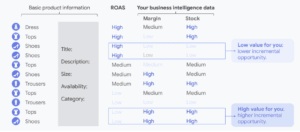3 Tips for Running a Successful Google Shopping Campaign
One of the most important channels for any e-commerce brand is Google Shopping. Whilst also a form of PPC advertising, these image ads you see at the top of the search engine results page differ from PPC text ads.
If you haven’t thought of using Google Shopping to help promote your products to your target audience, or if you’re considering running Google Shopping but not sure where to start, then we’re here to help. These are 3 top tips for running Google Shopping campaigns to ensure success and maximise ROAS.
-
Optimise your product feed
One of the most neglected areas in Google Shopping is optimising the product feed. Unlike PPC text ads, you don’t specify the keywords your ad shows for but rather it is dictated by the information in your product feed. Well-optimised product pages on your website not only help improve your SEO but when pulled into your Google Shopping feed, can vastly improve the visibility and performance of your ads.
Your website may also miss certain attributes that can also improve your shopping performance such as colour, size, and brand. These can be added in through Google Merchant Centre by an additional file or a supplement feed to offer Google more information to help serve your ad to the right customer.
With the evolution of Google Shopping and the transition to Smart Shopping and now Performance Max, negative keywords are now a thing of the past so it is more important than ever to ensure your feed’s core attributes such as title and description are well optimised. What makes sense as a title on your webpage product might not make sense for the right search on Google Shopping. For example, you may be selling a child’s toy that on your website is labelled as a ‘helicopter’. While this is obvious alongside the image on the site, to Google, you will likely trigger irrelevant (and very high volume) search queries. A better title for Google Shopping would be something like ‘Wooden Helicopter Toy + Brand Name’ making it much more descriptive for the search engine to understand.
-
Structure your campaigns based on ROAS goals
Whilst it’s easy to put all your products from your feed into one campaign and hope for the best, the most successful PPC accounts will tailor a campaign structure based on ROAS goals. If you sell clothing, for example, it may be that you split your dress category into 3 for high, medium, and low-margin products.
This then allows you to allocate higher budgets to products and categories where your return is higher. You can also set different target ROAS bidding targets for each campaign to effectively manage performance and return.

Also important to consider is that as Google Shopping campaigns gather data, they can begin to favour a set number of products based on performance metrics and therefore some of the products you are hoping to push may be served less from the campaign. It is also therefore important to review your products in each campaign and potentially segment further.
-
Utilise Performance Max
Launched in 2021, the success of Performance Max campaigns led Google to announce that in Q3 of 2022 it will replace existing Smart Shopping campaigns. Performance Max is an automated campaign that utilises the information provided (images, text, audience signals, URLs) by the advertiser to serve the ad to the right audience, including utilising the shopping feed. These ads can run across any Google network including Search, Shopping, Display, YouTube, Gmail, and Discovery.
Your Performance Max structure should still follow the same logic as above and utilise ROAS goals to split your campaigns. It is also important to note that you shouldn’t run the same products in a Google Shopping and Performance Max campaign. If you do this, your Google Shopping campaign will drop in serving as Performance Max will be prioritised.
Running successful Google shopping campaigns can significantly increase your brand’s sales and return on investment. If you’re struggling with how to get set up or how to run a campaign, then get in touch with our PPC team who can discuss the right strategy for you.

